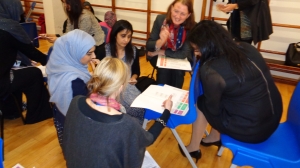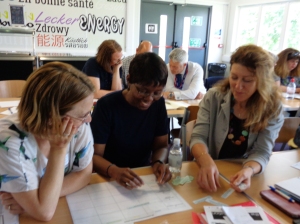
Dianne Excell is the national coordinator for NALDIC’s regional interest groups. In this post, she tells us why they’re important and what you can expect if you come to one. She also introduces the first of her in-depth reports on what’s happening in different RIGs around the country, starting with her own in Yorkshire and the Humber.
Why do we need Regional Interest Groups?
In the constantly changing educational climate, the once ring-fenced Ethnic Minority Achievement Grant (EMAG) is no longer available; funding to Local Authority central services has been reduced as money is paid directly to academies and free schools; EAL services have been diluted or even ruthlessly ‘deleted’ and changes to Initial Teacher Training mean that often new teachers are not adequately prepared to teach learners of EAL in their classrooms. It is well known that the number of EAL pupils is increasing year on year and there is an urgent need for continuing CPD for all professionals in the field. As a consequence, NALDIC has been developing its network of regional groups (or ‘RIGs’) to support colleagues in different contexts in different regions.
Where can we join a RIG?

We have groups across the country! We started, back in 2012, with RIGs in two regions: West Midlands and Yorkshire and the Humber. By September 2016 there were four active RIGs as South- and North London joined West Midlands and Y&H. By the end of 2016, South Wales, Oxfordshire and Berkshire and Hampshire had held well-attended inaugural meetings. The number of RIGs has grown amazingly in 2017 to include Kent, North West, East Midlands, South West and North East – a 200% increase since September 2016. There are several more in the pipeline, all because of the dedication and enthusiasm of our Volunteer Regional Convenors.
What happens at a RIG?
Most regions meet once a term and there is usually a theme. Contributions by practitioners from all educational settings are welcomed – sometimes including visiting international researchers to complement regional expertise. RIGs offer support which demonstrates effective practice, informed by recent research, which is relevant to the needs of local schools. Additionally, colleagues from more remote areas can network instead of feeling isolated.
What’s happening in … Yorkshire and the Humber
In this series of Blogs, starting with Yorkshire and the Humber, I will focus on individual RIGs to give a flavour of what you can expect.
In Yorkshire and Humberside, Jean Conteh and I decided to grasp the nettle to start a RIG in October 2012. Since then, twelve very successful RIGs have been organised across the region. We meet termly but, because Yorkshire and the Humber is such a large geographic area, each meeting has had a different venue (Leeds, York, Sheffield, Bradford, Harrogate, Hull, Doncaster, Wakefield, Dewsbury and Grimsby).
At our first meeting, the theme was ‘Getting to know each other while sharing interests, experiences, concerns and expertise’. Colleagues represented much of Y&H: Bradford, Calderdale, Kirklees, Leeds, Sheffield and York and also included a visiting research fellow from Nanjing University. The spread of expertise ranged from university and college academics, to secondary and primary school teachers as well as a representative from the Leeds NHS Speech and Language Therapy Service. Interests ranged from formative assessment to World Englishes, via the silent period and action research. Discussion of current issues included the 2012 GCSE English debacle; the disappearance of creativity in KS2 with the arrival of the SPaG tests; the consequences of the KS1 phonics tests for EAL (and other) learners; concern about the ways that research was being ignored … and much more.
The themes in subsequent meetings have grown out of each previous meeting:
 Multilingual families included literacy aspects of the ‘Born in Bradford’ project; research into the social factors that support or impede multilingual children’s language learning; a DVD about Gipsy Roma pupils in the Czech Republic; a new model of withdrawal provision for the growing numbers of Roma pupils in East Sheffield; a small ethnographic study on family involvement in learning.
Multilingual families included literacy aspects of the ‘Born in Bradford’ project; research into the social factors that support or impede multilingual children’s language learning; a DVD about Gipsy Roma pupils in the Czech Republic; a new model of withdrawal provision for the growing numbers of Roma pupils in East Sheffield; a small ethnographic study on family involvement in learning.
 Multilingualism in the classroom showcased the EAL Champions scheme in primary and secondary schools in Sheffield; research into primary Science teaching and learning; promoting bilingualism and community languages; HoLA, the Home Languages Accreditation Project.
Multilingualism in the classroom showcased the EAL Champions scheme in primary and secondary schools in Sheffield; research into primary Science teaching and learning; promoting bilingualism and community languages; HoLA, the Home Languages Accreditation Project.
- EAL: what’s happening in the classroom? started with a discussion of Safford and Drury’s 2013 article about ‘the ‘problem’ of bilingual children in educational settings’ (sent round as pre-reading); other topics included: collaborative developmental work with Bengali and Pakistani heritage students; a reading project with parents of EAL pupils; Bloom’s Taxonomy and EAL learners and a Strategy Mat linked to the NASSEA language acquisition steps; a project inspiring young Asian writers; experimental drama to develop literacy with EAL learners at three different stages of language development; the work of the Schools Linking Network (based in Bradford).
 EAL in different contexts included contributions from York, Durham and Grimsby where there are more isolated learners, which contrasted with a presentation about Bradford where some schools have almost 100% EAL/advanced bilingual learners. Other colleagues spoke about a community celebration day, induction for new arrivals in North Yorkshire and research on ideologies related to ‘Standard English’ norms in a changing world.
EAL in different contexts included contributions from York, Durham and Grimsby where there are more isolated learners, which contrasted with a presentation about Bradford where some schools have almost 100% EAL/advanced bilingual learners. Other colleagues spoke about a community celebration day, induction for new arrivals in North Yorkshire and research on ideologies related to ‘Standard English’ norms in a changing world.
 Tried and tested strategies for new arrivals included a workshop on ‘Racing to English’; ESOL for all at a Leeds secondary school which had recently been in the national headlines; welcome packs for new arrivals and their parents; scaffolding science language for new arrivals in the Early years; linking learning from complementary to mainstream. We also learned from a guest speaker how more creative approaches were being introduced at an English language school in Bahrain.
Tried and tested strategies for new arrivals included a workshop on ‘Racing to English’; ESOL for all at a Leeds secondary school which had recently been in the national headlines; welcome packs for new arrivals and their parents; scaffolding science language for new arrivals in the Early years; linking learning from complementary to mainstream. We also learned from a guest speaker how more creative approaches were being introduced at an English language school in Bahrain.
Other themes have been Translanguaging; Linking theory to practice; Enhancing language learning; To withdraw or not to withdraw; Other adults in the classroom and topical themes such as the new DfE English Proficiency Scales or Managing Assessment for EAL Learners where various assessment frameworks were examined and discussed.
Presenters are invited to show and tell and usually speak for around 15 minutes followed by Q&A/discussion. We usually have some pre-reading on the theme – it’s not compulsory to read it but it just gets us started. There are regional, national and international updates on topical issues, conferences, resources and so on. Importantly, there is also a chance to network. In our first meeting, we allowed 2 hours and time has crept up to 3 hours – often colleagues network for longer once the meeting has ended.
What do participants say?
One colleague said that she thought our RIG was successful because it involves practitioners with expertise in all areas of EAL: lecturers and researchers in universities and colleges, LA consultants, primary and secondary teachers, NQTs, ITT students, resource providers and educational businesses.
“What a fantastic, enjoyable and incredibly friendly event. I loved every bit of it and I certainly didn’t mind travelling eighty miles there and back to attend. Great networking opportunities too. This event was brilliant – such an eye-opener and broadening of my horizons. I can’t wait for the next RIG.”
“We found the event highly inspiring: there was lots of food for thought and it was wonderful to meet such highly competent and enthusiastic practitioners and researchers.”
RIGS are free CPD and thus we are grateful for the generosity of colleagues to provide a free venue and a few refreshments. We welcome all EAL practitioners so you don’t have to be a NALDIC member to attend. I hope you might be tempted to join us, benefit from what is offered and become part of the NALDIC family. Look out for news of RIG meetings in all regions on the NALDIC website at: www.naldic.org.uk/naldic-events/
Can you help us to create more RIGs?
We are growing but we rely on our members to offer help to convene in regions not already covered. We are willing to offer support to get you started. All we need is a free venue with refreshments and practitioners to share their research and good practice. Now it’s up to you and I look forward to hearing from you.

The EAL Journal is published termly by NALDIC, the subject association for EAL. Visit www.naldic.org.uk to become a member.

